
The hardware and bandwidth for this mirror is donated by dogado GmbH, the Webhosting and Full Service-Cloud Provider. Check out our Wordpress Tutorial.
If you wish to report a bug, or if you are interested in having us mirror your free-software or open-source project, please feel free to contact us at mirror[@]dogado.de.

The goal of healthyR.ts is to provide a consistent verb
framework for performing time series analysis and forecasting on both
administrative and clinical hospital data.
You can install the released version of healthyR.ts from CRAN with:
install.packages("healthyR.ts")And the development version from GitHub with:
# install.packages("devtools")
devtools::install_github("spsanderson/healthyR.ts")This is a basic example which shows you how to generate random walk data.
library(healthyR.ts)
library(ggplot2)
df <- ts_random_walk()
head(df)
#> # A tibble: 6 × 4
#> run x y cum_y
#> <dbl> <dbl> <dbl> <dbl>
#> 1 1 1 0.0521 1052.
#> 2 1 2 0.000486 1053.
#> 3 1 3 0.0567 1112.
#> 4 1 4 0.125 1252.
#> 5 1 5 0.0825 1355.
#> 6 1 6 0.00340 1360.Now that the data has been generated, lets take a look at it.
df %>%
ggplot(
mapping = aes(
x = x
, y = cum_y
, color = factor(run)
, group = factor(run)
)
) +
geom_line(alpha = 0.8) +
ts_random_walk_ggplot_layers(df)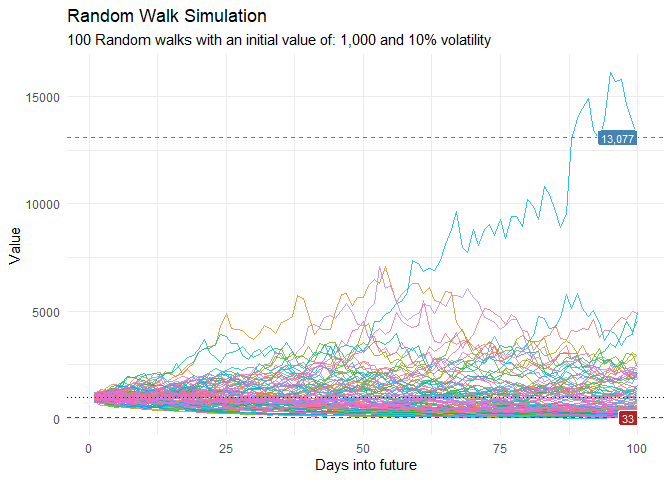
That is still pretty noisy, so lets see this in a different way. Lets clear this up a bit to make it easier to see the full range of the possible volatility of the random walks.
library(dplyr)
library(ggplot2)
df %>%
group_by(x) %>%
summarise(
min_y = min(cum_y),
max_y = max(cum_y)
) %>%
ggplot(
aes(x = x)
) +
geom_line(aes(y = max_y), color = "steelblue") +
geom_line(aes(y = min_y), color = "firebrick") +
geom_ribbon(aes(ymin = min_y, ymax = max_y), alpha = 0.2) +
ts_random_walk_ggplot_layers(df)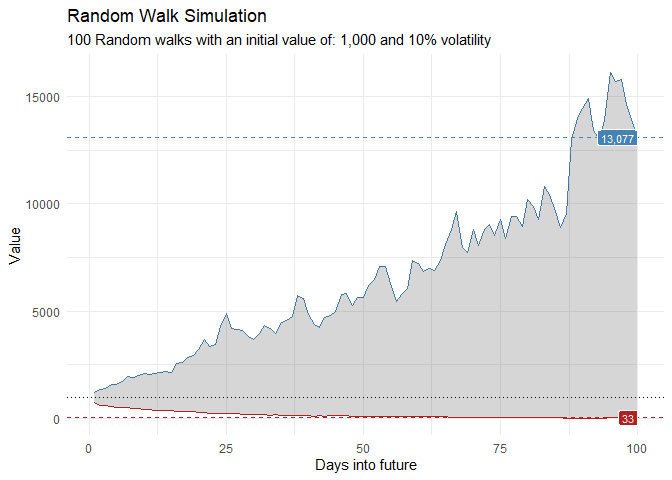
This package comes with a wide variety of functions from Data
Generators to Statistics functions. The function
ts_random_walk() in the above example is a Data
Generator.
Let’s take a look at a plotting function.
data_tbl <- data.frame(
date_col = seq.Date(
from = as.Date("2020-01-01"),
to = as.Date("2022-06-01"),
length.out = 365*2 + 180
),
value = rnorm(365*2+180, mean = 100)
)
ts_calendar_heatmap_plot(
.data = data_tbl
, .date_col = date_col
, .value_col = value
, .interactive = FALSE
)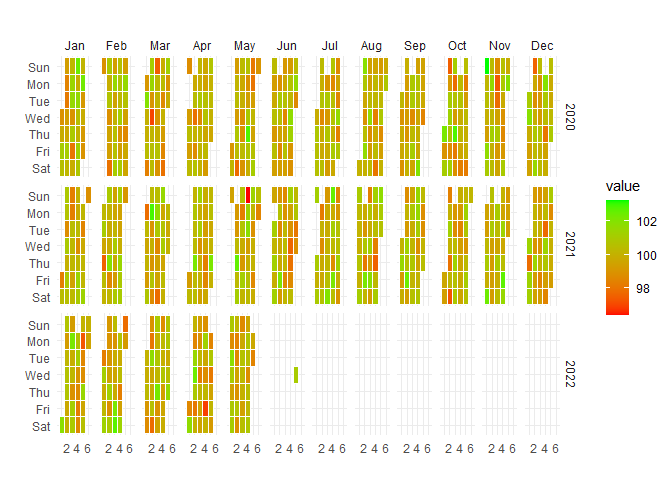
Time Series Clustering via Features:
data_tbl <- ts_to_tbl(AirPassengers) %>%
mutate(group_id = rep(1:12, 12))
output <- ts_feature_cluster(
.data = data_tbl,
.date_col = date_col,
.value_col = value,
group_id,
.features = c("acf_features","entropy"),
.scale = TRUE,
.prefix = "ts_",
.centers = 3
)
ts_feature_cluster_plot(
.data = output,
.date_col = date_col,
.value_col = value,
.center = 2,
group_id
)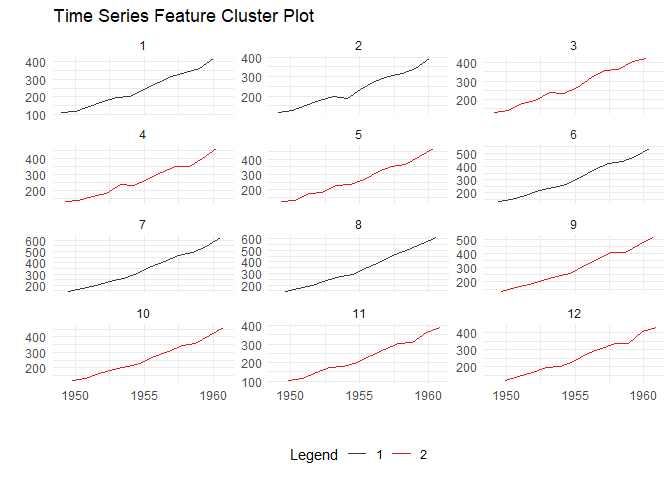
#> $plot
#> $plot$static_plot
#>
#> $plot$plotly_plot
#>
#>
#> $data
#> $data$original_data
#> # A tibble: 144 × 4
#> index date_col value group_id
#> <yearmon> <date> <dbl> <int>
#> 1 Jan 1949 1949-01-01 112 1
#> 2 Feb 1949 1949-02-01 118 2
#> 3 Mar 1949 1949-03-01 132 3
#> 4 Apr 1949 1949-04-01 129 4
#> 5 May 1949 1949-05-01 121 5
#> 6 Jun 1949 1949-06-01 135 6
#> 7 Jul 1949 1949-07-01 148 7
#> 8 Aug 1949 1949-08-01 148 8
#> 9 Sep 1949 1949-09-01 136 9
#> 10 Oct 1949 1949-10-01 119 10
#> # ℹ 134 more rows
#>
#> $data$kmm_data_tbl
#> # A tibble: 3 × 3
#> centers k_means glance
#> <int> <list> <list>
#> 1 1 <kmeans> <tibble [1 × 4]>
#> 2 2 <kmeans> <tibble [1 × 4]>
#> 3 3 <kmeans> <tibble [1 × 4]>
#>
#> $data$user_item_tbl
#> # A tibble: 12 × 8
#> group_id ts_x_acf1 ts_x_acf10 ts_diff1_acf1 ts_diff1_acf10 ts_diff2_acf1
#> <int> <dbl> <dbl> <dbl> <dbl> <dbl>
#> 1 1 0.741 1.55 -0.0995 0.474 -0.182
#> 2 2 0.730 1.50 -0.0155 0.654 -0.147
#> 3 3 0.766 1.62 -0.471 0.562 -0.620
#> 4 4 0.715 1.46 -0.253 0.457 -0.555
#> 5 5 0.730 1.48 -0.372 0.417 -0.649
#> 6 6 0.751 1.61 0.122 0.646 0.0506
#> 7 7 0.745 1.58 0.260 0.236 -0.303
#> 8 8 0.761 1.60 0.319 0.419 -0.319
#> 9 9 0.747 1.59 -0.235 0.191 -0.650
#> 10 10 0.732 1.50 -0.0371 0.269 -0.510
#> 11 11 0.746 1.54 -0.310 0.357 -0.556
#> 12 12 0.735 1.51 -0.360 0.294 -0.601
#> # ℹ 2 more variables: ts_seas_acf1 <dbl>, ts_entropy <dbl>
#>
#> $data$cluster_tbl
#> # A tibble: 12 × 9
#> cluster group_id ts_x_acf1 ts_x_acf10 ts_diff1_acf1 ts_diff1_acf10
#> <int> <int> <dbl> <dbl> <dbl> <dbl>
#> 1 1 1 0.741 1.55 -0.0995 0.474
#> 2 1 2 0.730 1.50 -0.0155 0.654
#> 3 2 3 0.766 1.62 -0.471 0.562
#> 4 2 4 0.715 1.46 -0.253 0.457
#> 5 2 5 0.730 1.48 -0.372 0.417
#> 6 1 6 0.751 1.61 0.122 0.646
#> 7 1 7 0.745 1.58 0.260 0.236
#> 8 1 8 0.761 1.60 0.319 0.419
#> 9 2 9 0.747 1.59 -0.235 0.191
#> 10 2 10 0.732 1.50 -0.0371 0.269
#> 11 2 11 0.746 1.54 -0.310 0.357
#> 12 2 12 0.735 1.51 -0.360 0.294
#> # ℹ 3 more variables: ts_diff2_acf1 <dbl>, ts_seas_acf1 <dbl>, ts_entropy <dbl>
#>
#>
#> $kmeans_object
#> $kmeans_object[[1]]
#> K-means clustering with 2 clusters of sizes 5, 7
#>
#> Cluster means:
#> ts_x_acf1 ts_x_acf10 ts_diff1_acf1 ts_diff1_acf10 ts_diff2_acf1 ts_seas_acf1
#> 1 0.7456468 1.568532 0.1172685 0.4858013 -0.1799728 0.2876449
#> 2 0.7387865 1.528308 -0.2909349 0.3638392 -0.5916245 0.2930543
#> ts_entropy
#> 1 0.4918321
#> 2 0.6438176
#>
#> Clustering vector:
#> [1] 1 1 2 2 2 1 1 1 2 2 2 2
#>
#> Within cluster sum of squares by cluster:
#> [1] 0.3704304 0.3660630
#> (between_SS / total_SS = 59.8 %)
#>
#> Available components:
#>
#> [1] "cluster" "centers" "totss" "withinss" "tot.withinss"
#> [6] "betweenss" "size" "iter" "ifault"Time to/from Event Analysis
library(dplyr)
df <- ts_to_tbl(AirPassengers) %>% select(-index)
ts_time_event_analysis_tbl(
.data = df,
.horizon = 6,
.date_col = date_col,
.value_col = value,
.direction = "both"
) %>%
ts_event_analysis_plot()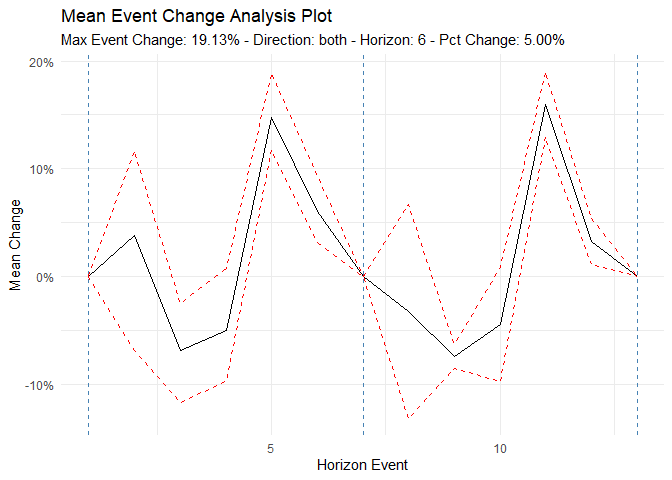
ts_time_event_analysis_tbl(
.data = df,
.horizon = 6,
.date_col = date_col,
.value_col = value,
.direction = "both"
) %>%
ts_event_analysis_plot(.plot_type = "individual")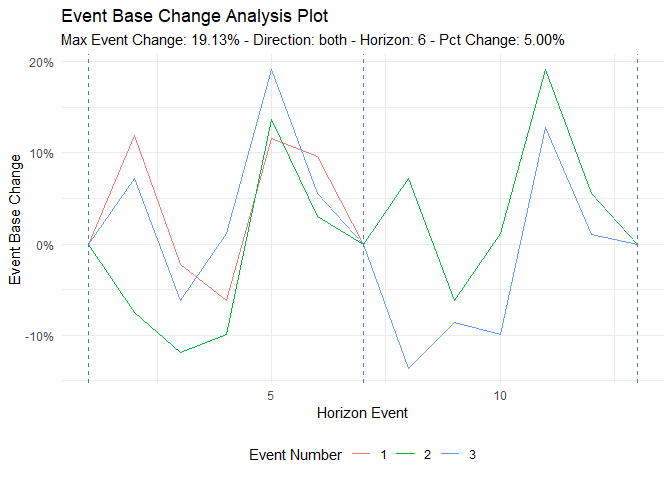
ARIMA Simulators
output <- ts_arima_simulator()
output$plots$static_plot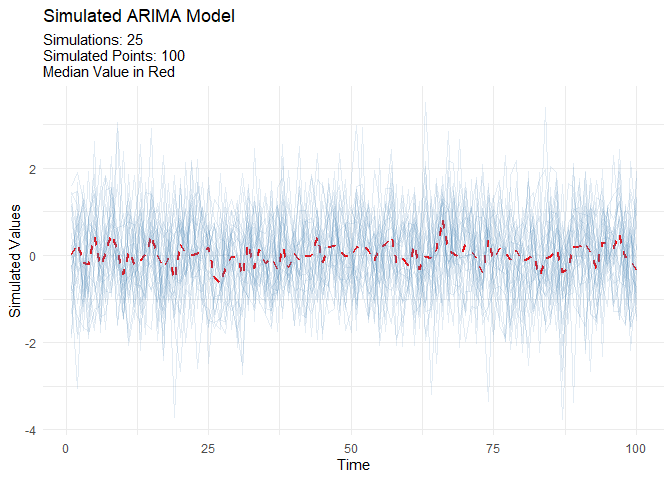
Automatic Workflows which can be thought of as Boiler Plate Time Series modeling. This is in it’s infancy in this package.
| Auto Workflows | Boilerplate Workflow |
|---|---|
| ts_auto_arima() | Boilerplate Workflow |
| ts_auto_arima_xgboost() | Boilerplate Workflow |
| ts_auto_croston() | Boilerplate Workflow |
| ts_auto_exp_smoothing() | Boilerplate Workflow |
| ts_auto_glmnet() | Boilerplate Workflow |
| ts_auto_lm() | Boilerplate Workflow |
| ts_auto_mars() | Boilerplate Workflow |
| ts_auto_nnetar() | Boilerplate Workflow |
| ts_auto_prophet_boost() | Boilerplate Workflow |
| ts_auto_prophet_reg() | Boilerplate Workflow |
| ts_auto_smooth_es() | Boilerplate Workflow |
| ts_auto_svm_poly() | Boilerplate Workflow |
| ts_auto_svm_rbf() | Boilerplate Workflow |
| ts_auto_theta() | Boilerplate Workflow |
| ts_auto_xgboost() | Boilerplate Workflow |
This is just a start of what is in this package!
These binaries (installable software) and packages are in development.
They may not be fully stable and should be used with caution. We make no claims about them.
Health stats visible at Monitor.